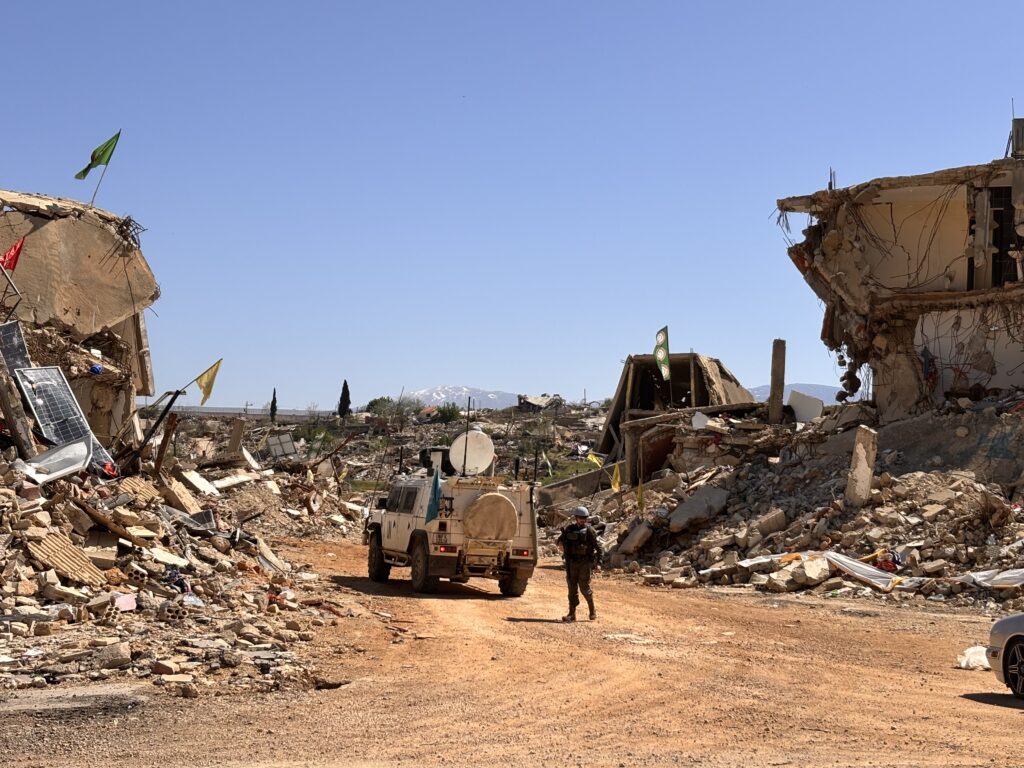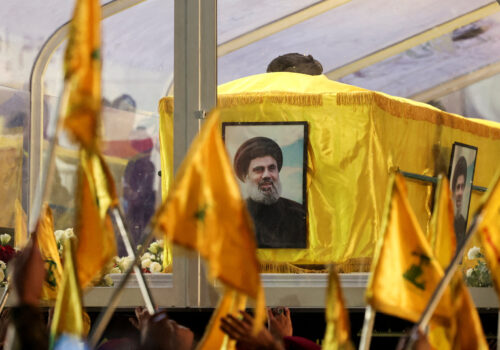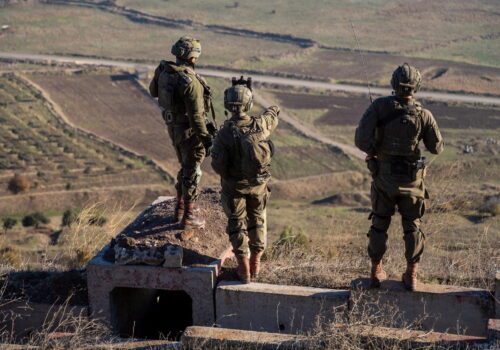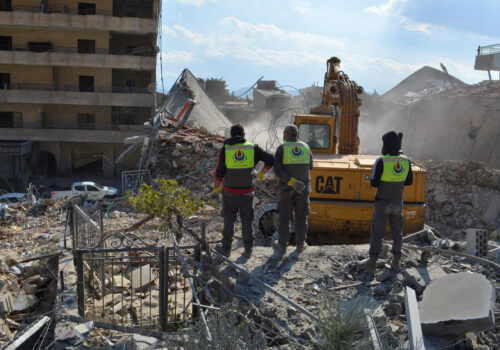Next month, Lebanon will mark the 25th anniversary of Israel’s troop withdrawal from its southern region after a two-decade-long occupation and eighteen year resistance campaign by Lebanon’s Hezbollah organization. But this year, the commemoration will be marred by the fact that Israeli forces are back on Lebanese soil, effectively maintaining a de facto buffer zone along the border for a depth of more than a kilometer.
Israeli troops are occupying five hills on or close to the border and using fire to prevent anyone from approaching too close to the Blue Line, the United Nations term for Lebanon’s southern frontier. That includes residents of border villages who are looking to rebuild homes shattered by the recent war. Israel has been employing drones and helicopters to attack prefabricated structures that have been erected on the rubble of houses in border villages, later claiming that it had destroyed “Hezbollah infrastructure”.
The view from the Blue Line
If anywhere in south Lebanon demonstrates the scale of the destruction inflicted on Lebanon during the recent 14-month war and its aftermath, it is Kfar Kila, a border village scattered over a hill opposite the Israeli town of Metulla. Kfar Kila, formerly home to more than 14,000 residents, has, to all intents and purposes, almost literally been wiped off the map.
“It was systematic destruction,” says Lieutenant Javier Sola Gomez, a Spanish platoon commander with the United Nations peacekeeping force known as UNIFIL. He added that no residents have returned to the village to live. “If anyone goes too close to the Blue Line, the Israelis fire warning shots at them.”
I know Kfar Kila well, having driven through it countless times for more than a quarter century. Yet moving on patrol through the village with UNIFIL, it was difficult to place exactly where we were at any given moment.

Barely a building still stands intact in the village. Most buildings have been reduced to sad piles of crushed cinder blocks, smashed reinforced concrete, shattered red tiles, and strewn with the humdrum household detritus of mattresses, sheets, broken furniture, plastic sheets, and paper. The few houses that remain standing are all damaged, some simply skeletal frames with no walls, others pockmarked with holes from tank rounds and blackened from fire. Even trees, including centuries-old olive groves, have been uprooted, cut down, or bulldozed. The scale of the damage is staggering—most of it having occurred after a November 27 ceasefire, when Israeli troops used dynamite and bulldozers to flatten what was not destroyed during the war.
Amid the destruction and the near-daily assassinations of suspected Hezbollah personnel by out-of-sight Israeli drones, Lebanese Armed Forces (LAF) soldiers are moving through the UNIFIL area of operations—also known as the South Litani Sector (SLS)—to locate and remove Hezbollah’s weapons and infrastructure in accordance with the ceasefire agreement. The agreement called for the deployment of ten thousand soldiers into South Lebanon, a significant commitment for the undermanned and under-resourced military. So far, an additional 1,500 soldiers have been dispatched to the south, bringing the total to six thousand, while another four thousand are being recruited and trained.
Hezbollah appears to have tacitly accepted yielding an area to the LAF that, before the recent war, it had manned with countless small military bases discreetly tucked into valleys and woods, underground bunker networks, firing ranges, and observation posts along the Blue Line. One of the more spectacular facilities handed to the LAF is the massive underground missile bunker located in a valley between the villages of Aitit and Jwaya. The bunker, dubbed by Hezbollah Imad-4 (inferring that there are at least three other similar facilities elsewhere), was featured in a propaganda video in August 2024 in which trucks loaded with missiles trundled through tunnels accompanied by uniformed fighters on motorcycles.
The LAF has conducted more than 5,500 searches in the SLS since the ceasefire commenced, three thousand independently and 2,500 alongside UNIFIL peacekeepers, LAF Commander General Rudolph Haykel told the Lebanese government on April 17. The LAF receives information on Hezbollah military locations from UNIFIL and from the US-led Ceasefire Monitoring Mechanism, known as the “Mechanism”. UNIFIL has been collating Hezbollah sites, or what it dubs “locations of interest”, for years, but was usually unable to visit them before the war. The other primary source of information for the LAF on Hezbollah sites is from the Mechanism, which receives the intelligence from Israel via the United States. According to internal UNIFIL statistics, the LAF has inspected 50 percent of locations passed on by UNIFIL and 72 percent of sites delivered by the Mechanism. A senior UNIFIL source commended the LAF for their efforts, especially given the manpower shortages, and said that the gap between LAF searches and identified sites will narrow as the number of unvisited locations in the SLS dries up.
The “resistance priority” in the crosshairs
The LAF deployment into the SLS and dismantling of Hezbollah military sites is seen as the opening step in a broader goal of disarming the Iran-backed group so that it reverts to a political and social organization only. Since taking office in January, President Joseph Aoun has repeatedly declared that only the Lebanese state should have the right to bear arms, implying that Hezbollah and other militant groups (mainly Palestinian factions) would have to surrender their weapons.
In a recent interview with the Qatari daily The New Arab, Aoun said he wished to make 2025 the “year of the state monopoly on arms.”
“The decision has been made to place all weapons under the state. The execution will happen through dialogue, which I believe must be bilateral between the presidency and Hezbollah,” he added.
Hezbollah officials have repeatedly stated that the organization is willing to discuss the fate of its arms in the context of a national defense strategy, but not until Israel has withdrawn from Lebanese territory, ceased its attacks against Hezbollah, and has released the prisoners it captured during the recent war. Lately, however, senior Hezbollah officials, including its leader, Sheikh Naim Qassem, have adopted a tougher line, rejecting the notion of disarming altogether.
“We will not allow anyone to disarm Hezbollah or the Resistance because Hezbollah and the Resistance are one and the same. The very notion of disarmament must be removed from our vocabulary. We will not let anyone strip the Resistance of its weapons—these arms are the backbone of the Resistance,” Qassem said in a speech on April 18.
SIGN UP FOR THIS WEEK IN THE MIDEAST NEWSLETTER
“We will confront anyone who attacks the Resistance or works to disarm it—regardless of whether they are Israel, America, or their collaborators.”
If Hezbollah refuses to disarm, Lebanon will face increasing pressure from the US which could jeopardize the critical financial assistance program to the LAF, and further dampen any hopes of securing international funding to not only repair the damage of the latest war but also to help Lebanon climb its way out of the current economic slump. Israel, which has not stopped attacking Hezbollah targets since the ceasefire in November, would almost certainly escalate its attacks, possibly to the extent of resuming the war, such is the extent to which Hezbollah’s deterrence has been shattered against its traditional enemy. Few Lebanese outside the Shia community would have much sympathy for Hezbollah if it continued to cling to its arms, especially if it triggered a renewed conflict with Israel.
On the other hand, the dilemma facing Hezbollah is what would remain of the organization if it were to surrender its weapons and dismantle the Islamic Resistance. Hezbollah has a formidable social welfare apparatus, including hospitals, clinics, and schools, as well as a potent parliamentary presence and seats in government—all of which have helped extend its domestic influence and bind its Shia constituency to the party over the years. But its military component—what Hezbollah calls the “resistance priority”—is the beating heart of the organization and its core raison d’être.
After all, when Hezbollah was established in 1982, it was not with the intention of opening schools and hospitals to improve the education and health of Lebanon’s Shia community. It was founded to resist the then-Israeli occupation of Lebanon as a precursor to the more ideological goal of eradicating Israel and restoring Palestine to the Palestinians. Hezbollah is fundamentally an ideologically-driven military entity. From Iran’s perspective, Hezbollah has been a useful source of deterrence against the possibility of Israel launching an attack against its nuclear facilities, and as a force enabler to extend Tehran’s influence across the Middle East.
The Iran factor
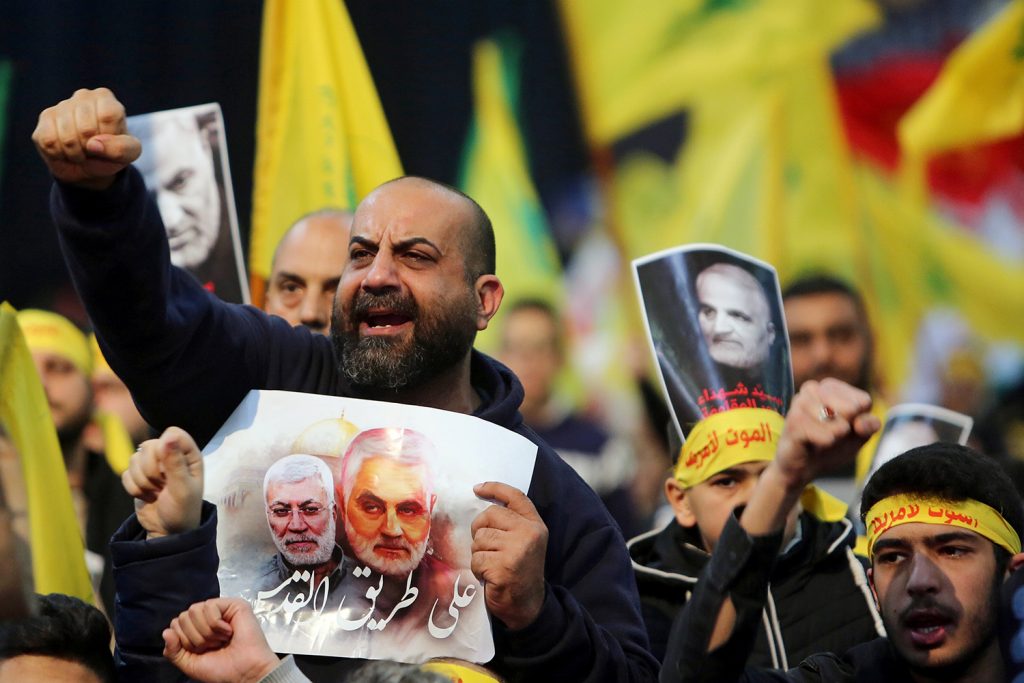
In the unlikely event that Hezbollah voluntarily yielded its weapons to the Lebanese state, it would lose its value to Iran. Tehran would probably conclude that there was no longer any point in channeling funds to its Lebanese proxy if Hezbollah intended to limit its activities to domestic politics. Although Hezbollah has its own revenue sources, they are almost certainly too limited to cover the enormous costs of running its social welfare apparatus and paying salaries. If no other external source of funding can be found, presumably the schools and hospitals would close, with tens of thousands of employees and fighters losing their jobs and sources of income. The LAF may be able to absorb some fighters, but certainly not all the estimated fifty thousand to seventy thousand combatants that make up the Islamic Resistance. The result could see Hezbollah becoming a hollowed-out shell of its former self.
The key decision maker as to whether Hezbollah disarms or not is Iran. It is unclear so far if Iran’s policy toward Hezbollah will change in light of the recent war. If Iran decides that Hezbollah must be rebuilt, the challenge would be enormous, especially as Syria, which was once a vital geo-strategic lynchpin linking Iran to Hezbollah, has fallen into the hands of its Sunni Islamist opponents.
Israel, certainly, will not stand by quietly as Hezbollah reorganizes and rearms. On the other hand, Iran may conclude that Hezbollah can no longer serve as a factor of deterrence against Israel, which significantly reduces its utility to Tehran. In such an event, Hezbollah’s value would be limited to winning concessions from the US in exchange for agreeing to see its Lebanese partner disarmed. Therefore, a disarmament process could ultimately result in a Hezbollah in name only, with a few lawmakers in parliament, a couple of seats in government, and surrounded by political opponents who brim with schadenfreude at the decline of the once seemingly invincible Hezbollah. Not a particularly palatable outcome for the party’s leadership.
Nicholas Blanford is a nonresident senior fellow with the Atlantic Council’s Middle East Programs, covering the politics and security affairs of Lebanon and Syria. He is an acknowledged expert on Lebanese Hezbollah. Blanford is a Beirut-based consultant and a defense and security correspondent for IHS/Jane’s.
Further reading
Tue, Apr 15, 2025
Weakened by Israel, Hezbollah turns to spin games to hold support
MENASource By David Daoud
Hezbollah's more cautious posturing on Israel in recent weeks demonstrates the militant group knows it’s in no condition to fight.
Tue, Apr 1, 2025
Israel is making a miscalculation in southern Syria. Here is why.
MENASource By Ömer Özkizilcik
Israel’s approach in southern Syria risks deepening sectarian divisions, eroding the Druze community’s standin, and fueling broader instability.
Tue, Mar 25, 2025
Dispatch from Bekaa: Inside the sectarian skirmishes on the Syria-Lebanon border
MENASource By Nicholas Blanford
Local Shia tribesmen have battled an assortment of Sunni jihadist militias and the new Syrian security forces dominated by Hayat Tahrir al-Sham (HTS).
Image: Spanish UNIFIL peacekeepers on patrol through the devastated village of Kfar Kila on Lebanon’s southern border with Israel. Photo Credit: Nicholas Blanford
